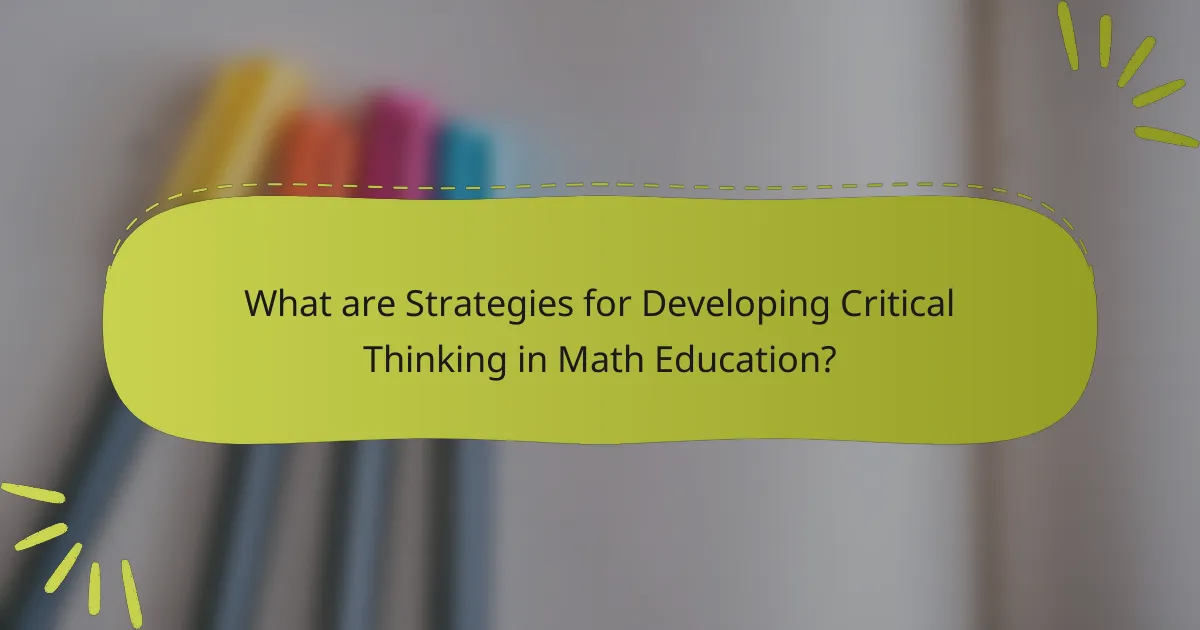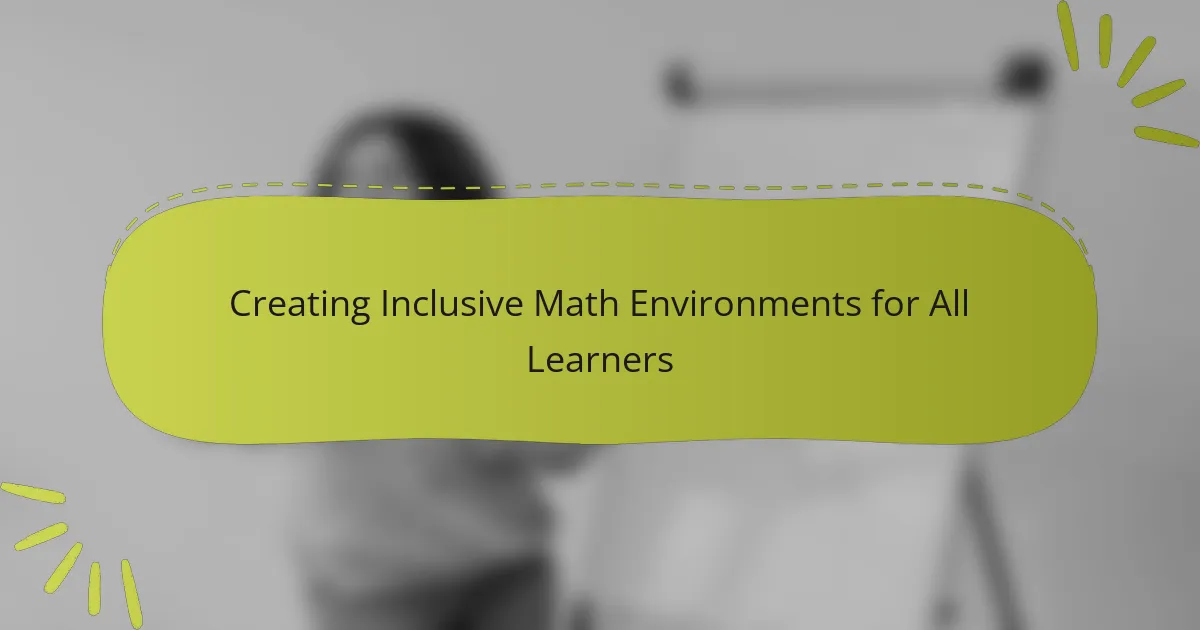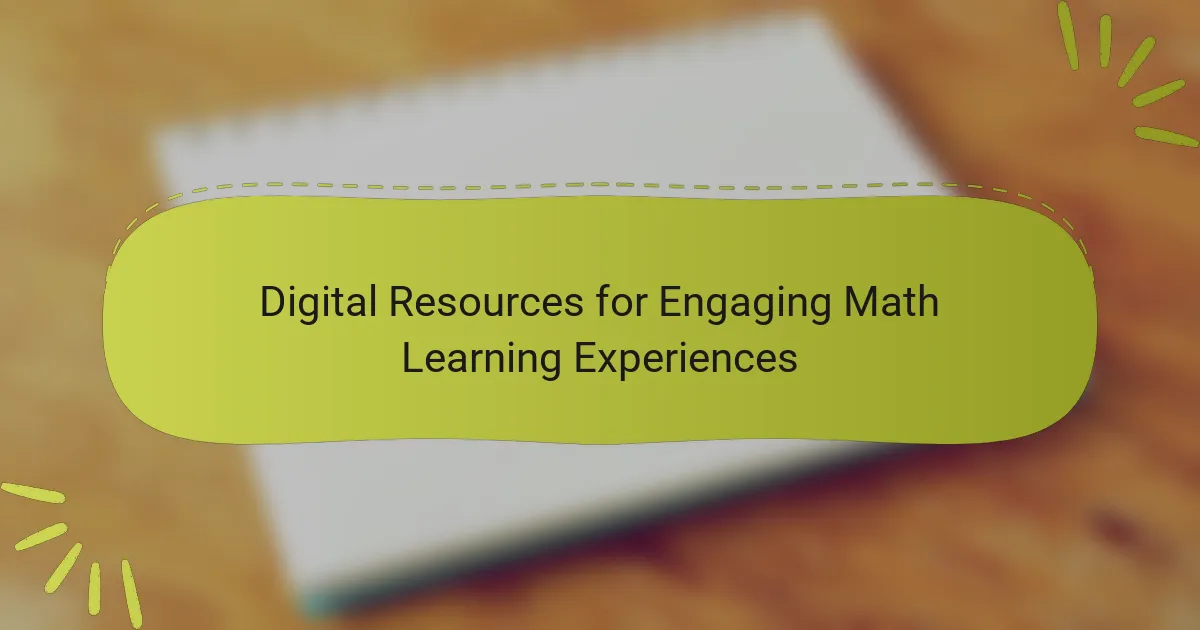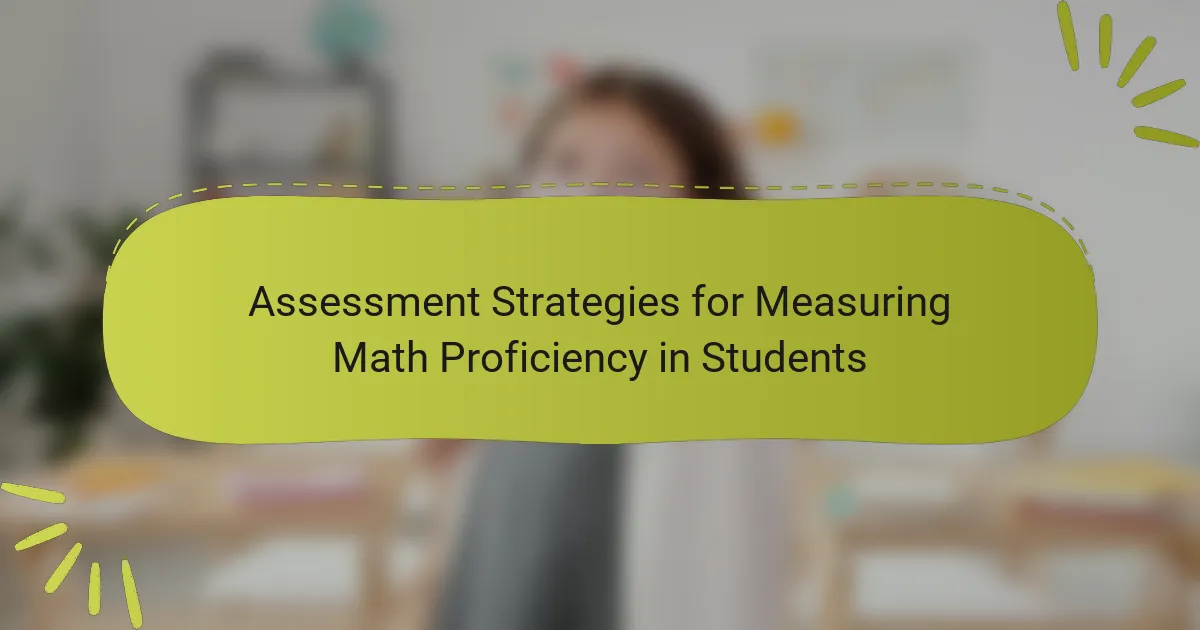The article focuses on strategies for developing critical thinking in math education. Key methods include problem-based learning, which encourages students to tackle real-world problems; Socratic questioning, which promotes deeper understanding through dialogue; and collaborative learning, which enhances teamwork and diverse perspectives. Additionally, the integration of technology is highlighted as a means to create interactive experiences that challenge students’ reasoning. Research indicates that these strategies significantly improve student engagement and conceptual understanding in mathematics, ultimately leading to enhanced problem-solving skills and better preparation for complex tasks.

What are Strategies for Developing Critical Thinking in Math Education?
Strategies for developing critical thinking in math education include problem-based learning, Socratic questioning, and collaborative learning. Problem-based learning encourages students to solve real-world problems, fostering analytical skills. Socratic questioning stimulates deeper understanding through dialogue and inquiry. Collaborative learning promotes teamwork and diverse perspectives, enhancing critical thinking. Additionally, integrating technology can provide interactive experiences that challenge students’ reasoning. Research shows that these strategies improve students’ engagement and conceptual understanding in mathematics. Implementing these methods leads to better problem-solving skills and prepares students for complex tasks.
Why is critical thinking important in math education?
Critical thinking is important in math education because it enhances problem-solving skills. It allows students to analyze and evaluate mathematical concepts critically. This skill helps them approach complex problems systematically. Research shows that students who engage in critical thinking perform better in math assessments. A study published in the Journal of Educational Psychology found that critical thinking skills correlate with improved math achievement. Furthermore, critical thinking fosters creativity in finding multiple solutions. It encourages students to justify their reasoning and understand underlying principles. This depth of understanding leads to greater confidence in their mathematical abilities.
How does critical thinking enhance problem-solving skills in math?
Critical thinking enhances problem-solving skills in math by promoting logical reasoning and analytical skills. It allows students to evaluate problems from multiple perspectives. This approach encourages deeper understanding of mathematical concepts. Students learn to identify relevant information and discard irrelevant data. Critical thinking also fosters the ability to develop and test hypotheses. It enables learners to approach complex problems systematically. Research shows that students who engage in critical thinking perform better in math assessments. A study by the National Council of Teachers of Mathematics highlights this connection. Effective problem-solving in math relies heavily on these critical thinking skills.
What role does critical thinking play in understanding mathematical concepts?
Critical thinking is essential for understanding mathematical concepts. It enables students to analyze problems, evaluate solutions, and make connections between ideas. Through critical thinking, learners can break down complex equations into manageable parts. This skill helps in recognizing patterns and applying logical reasoning. Research indicates that students who engage in critical thinking perform better in mathematics. A study by Ennis (1996) highlights that critical thinking enhances problem-solving abilities in math. Therefore, fostering critical thinking skills can significantly improve mathematical comprehension and application.
What are the key strategies for fostering critical thinking in math?
Key strategies for fostering critical thinking in math include encouraging problem-solving, promoting collaborative learning, and integrating real-world applications. Problem-solving activities stimulate analytical thinking and require students to explore multiple solutions. Collaborative learning allows students to discuss and critique each other’s reasoning, enhancing their understanding. Real-world applications help students connect mathematical concepts to everyday situations, making learning relevant. Research shows that these strategies improve student engagement and understanding. A study by Hattie (2012) emphasizes the importance of feedback in developing critical thinking skills.
How can inquiry-based learning be applied in math education?
Inquiry-based learning can be applied in math education by encouraging students to explore mathematical concepts through questioning and investigation. This approach allows students to engage actively with the material. Teachers can present real-world problems that require mathematical reasoning. Students can then formulate their own questions and hypotheses related to these problems.
For example, a teacher might ask students to determine the most efficient way to allocate resources for a project. Students would need to use mathematical principles to analyze various solutions. This method fosters critical thinking as students evaluate their findings and reflect on their learning process. Research shows that inquiry-based learning enhances problem-solving skills and conceptual understanding in mathematics. According to a study by Hattie (2009), inquiry-based approaches significantly improve student engagement and achievement in math.
What is the impact of collaborative learning on critical thinking in math?
Collaborative learning significantly enhances critical thinking in math. This approach encourages students to discuss and analyze mathematical concepts together. Engaging in dialogue fosters deeper understanding and promotes diverse perspectives. Research shows that students involved in collaborative learning demonstrate improved problem-solving skills. A study by Johnson and Johnson (1999) found that cooperative learning leads to higher achievement and critical thinking. Collaborative environments challenge students to articulate their reasoning and question their peers. This process develops analytical skills essential for complex mathematical tasks. Overall, collaborative learning is a powerful strategy for enhancing critical thinking in math education.
How can technology be integrated into math education to promote critical thinking?
Technology can be integrated into math education to promote critical thinking by utilizing interactive software and online resources. These tools allow students to explore mathematical concepts in a hands-on manner. For example, dynamic geometry software enables learners to manipulate shapes and observe the effects of their changes. This fosters a deeper understanding of geometric principles.
Additionally, online platforms provide access to a variety of problem-solving scenarios. Students can engage in collaborative projects through these platforms. This collaboration encourages discussion and the exchange of ideas, enhancing critical thinking skills.
Furthermore, adaptive learning technologies can tailor math problems to individual student needs. This personalization helps students tackle challenges at their own pace, promoting resilience and critical analysis. Research indicates that technology-enhanced learning environments lead to improved problem-solving abilities in students.
Overall, integrating technology in math education effectively supports the development of critical thinking skills.
What tools and resources are effective for enhancing critical thinking in math?
Effective tools and resources for enhancing critical thinking in math include problem-solving software, manipulatives, and collaborative learning platforms. Problem-solving software, like GeoGebra, allows students to visualize and interact with mathematical concepts. Manipulatives, such as blocks or counters, help to concretize abstract ideas. Collaborative learning platforms, such as Google Classroom, facilitate group discussions and peer feedback. These resources promote deeper understanding and encourage students to explore multiple solutions. Research shows that using varied tools can significantly improve students’ analytical skills in mathematics.
How does online learning facilitate critical thinking in mathematics?
Online learning facilitates critical thinking in mathematics by providing interactive platforms that encourage problem-solving. These platforms often include simulations and real-time feedback. Students engage with mathematical concepts through diverse methods, enhancing their understanding. Online discussions foster collaboration and the exchange of ideas. This collaborative environment challenges students to articulate their reasoning. Additionally, access to varied resources supports independent exploration of mathematical problems. Research shows that online environments can lead to deeper cognitive engagement. For example, a study by Zhao et al. (2020) found that students in online settings demonstrated improved critical thinking skills compared to traditional classrooms.
What challenges do educators face in developing critical thinking in math?
Educators face several challenges in developing critical thinking in math. One major challenge is the traditional focus on rote memorization. This approach limits opportunities for deeper understanding and analysis. Another challenge is the lack of training in teaching critical thinking skills. Many educators are not equipped with strategies to foster these skills effectively. Additionally, standardized testing often prioritizes quick, correct answers over critical analysis. This pressure can discourage innovative thinking in students. Furthermore, classroom environments may not always encourage collaborative problem-solving. Students may feel hesitant to share their ideas or ask questions. Lastly, varying student backgrounds and abilities can complicate tailored instruction. Educators must navigate these diverse needs to promote critical thinking effectively.
How can teachers overcome resistance to critical thinking approaches?
Teachers can overcome resistance to critical thinking approaches by actively engaging students in the learning process. They should create a supportive classroom environment that encourages questioning. Providing relevant real-world examples can make critical thinking more relatable. Teachers can also incorporate collaborative learning activities, allowing students to discuss and challenge ideas. Offering structured guidance helps students navigate complex problems. Regular feedback reinforces the value of critical thinking in their learning journey. Research shows that students who practice critical thinking perform better academically. A study by Facione (2011) highlights the positive impact of critical thinking on student success.
What misconceptions about math can hinder critical thinking development?
Misconceptions about math that can hinder critical thinking development include the belief that math is solely about memorization. This view limits students’ ability to understand concepts deeply. Another misconception is that math is only for certain ‘gifted’ individuals. This belief discourages many from engaging with the subject. Additionally, thinking that there is only one correct method to solve problems can stifle creativity. This restricts students from exploring multiple solutions and approaches. Lastly, the idea that math has no real-world application can lead to disinterest. Understanding that math is integral to various fields can enhance motivation and critical thinking.
How can assessment methods be adapted to evaluate critical thinking in math?
Assessment methods can be adapted to evaluate critical thinking in math by incorporating open-ended questions. These questions require students to explain their reasoning and problem-solving processes. Additionally, using real-world scenarios can help assess students’ ability to apply mathematical concepts critically. Collaborative group assessments can also encourage discussion and deeper understanding of mathematical principles. Rubrics that focus on reasoning and justification can help evaluate the quality of students’ critical thinking. Research indicates that these methods promote higher-order thinking skills in mathematics education.
What types of assessments best measure critical thinking skills in mathematics?
Performance-based assessments best measure critical thinking skills in mathematics. These assessments require students to apply mathematical concepts to real-world problems. They often involve open-ended questions that promote reasoning and justification. Examples include project-based tasks and mathematical modeling scenarios. Additionally, formative assessments like think-alouds and peer assessments can effectively gauge critical thinking. Research indicates that such assessments encourage deeper understanding and application of mathematical principles. According to a study by the National Council of Teachers of Mathematics, performance tasks significantly enhance critical thinking in math education.
How can formative assessments support the development of critical thinking?
Formative assessments can enhance critical thinking by providing ongoing feedback and opportunities for self-reflection. These assessments encourage students to analyze their thought processes and reasoning. They promote active engagement with material, leading to deeper understanding. Research indicates that formative assessments can increase student motivation and self-efficacy. For example, a study by Black and Wiliam (1998) found that formative assessment practices significantly improve student learning outcomes. By using formative assessments, educators can identify areas where students struggle and adjust instruction accordingly. This targeted feedback fosters a growth mindset, essential for developing critical thinking skills in math education.
What are some practical tips for implementing critical thinking strategies in math education?
Encouraging students to ask questions is a practical tip for implementing critical thinking in math education. This approach fosters curiosity and deeper understanding. Teachers can model questioning techniques during lessons. Incorporating real-world problems helps students apply math concepts critically. Group work promotes discussion and collaborative problem-solving. Using open-ended questions allows for multiple solution pathways. Encouraging reflection on problem-solving processes enhances metacognitive skills. Regularly assessing students’ reasoning and thought processes supports critical thinking development.
The main entity of the article is “Strategies for Developing Critical Thinking in Math Education.” This article outlines effective strategies for enhancing critical thinking in mathematics, including problem-based learning, Socratic questioning, and collaborative learning. It emphasizes the importance of critical thinking for improving problem-solving skills and understanding mathematical concepts. Additionally, the article discusses the role of technology, inquiry-based learning, and assessment methods in fostering critical thinking, while addressing challenges educators face in this process. Practical tips for implementation are also provided to support educators in developing critical thinking skills among students.



